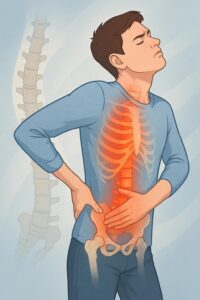Ankylosing Spondylitis (AS) is a chronic autoimmune inflammatory arthritis that primarily affects the spine and sacroiliac joints (where the spine meets the pelvis). Over time, AS can cause the vertebrae to fuse together, resulting in a rigid or curved spine, known as “bamboo spine.”
The disease can also affect other joints, eyes, and organs, and symptoms tend to appear in young adults, especially men under 40.

